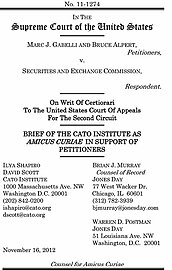Learn more about Cato’s Amicus Briefs Program.
Statutes of limitations exist for good reason: Over time, evidence can be corrupted or disappear, memories fade, and companies dispose of records. Moreover, people want to get on with their lives and not have legal battles from their past come up unexpectedly. Plaintiffs thus have a responsibility to bring charges within a reasonable time of injury so that the justice system can operate efficiently and effectively — and that is doubly so when the would-be plaintiff is the government, with all its tools for investigation and enforcement. There is a general federal statute of limitations, therefore, 28 U.S.C. § 2462, which protects liberty by prohibiting government actions “for the enforcement of any civil fine, penalty, or forfeiture … unless commenced within five years from the date when the claim first accrued.” In April 2008, however, the Securities & Exchange Commission sued the managers of Gabelli Funds LLC, a mutual fund, for civil penalties relating to conduct that ceased in August 2002, more than five years earlier. The SEC alleged that Gabelli Funds defrauded investors by failing to disclose that the fund was allowing a favored investor to engage in “market timing” — buying and selling mutual fund shares in a manner designed to exploit short-term price swings. The U.S. Court of Appeals for the Second Circuit ruled that the SEC’s claim was nevertheless valid because courts should read into § 2462 an implicit “discovery rule” — a common exception to statutes of limitations that prevents fraud-based claims from accruing (“stops the clock” on the limitations period) until the plaintiff discovers, or with reasonable diligence should have discovered, the basis for the claim. Because of the allegedly fraudulent nature of the defendants’ actions, the court found that the government’s claim accrued not when their conduct ceased but a year later, when the violation was actually discovered. The Supreme Court decided to review the case, and Cato filed an amicus brief supporting the defendants. We make three points. First, Congress could not have intended a discovery rule to be implicit here because at the time the operative language in § 2462 was enacted, case law explicitly rejected a discovery rule — and since then Congress enacted numerous statutes with explicit discovery rules that would be superfluous if a discovery rule had already existed implicitly. Second, reading a discovery rule into § 2462 violates the principle of separation of powers by judicially changing the statute’s meaning: When judges rewrite laws, those laws fail to meet the constitutional requirement of bicameralism and presentment (“how a bill becomes a law”). Third, even if courts could alter rather than merely interpret the meaning of statutes, there’s no basis for creating a discovery rule for government enforcement actions. Government agencies with broad investigatory powers — indeed, whose purpose is to monitor regulatory compliance — don’t face the same difficulty as private plaintiffs in identifying causes of action which give rise to the discovery rule. Adding a discovery rule to § 2462 would create an indefinite threat of government lawsuits and invite agencies to review decades of past conduct of selectively disfavored companies and individuals — inevitably chilling innocent and valuable economic activity. To preserve individual liberty in the face of an ever-burgeoning regulatory state and ensure constitutional separation of powers, we urge the Court to reverse the Second Circuit’s decision and hold that no discovery rule applies in Gabelli v. SEC.

This work is licensed under a Creative Commons Attribution-NonCommercial-ShareAlike 4.0 International License.
